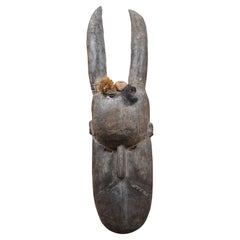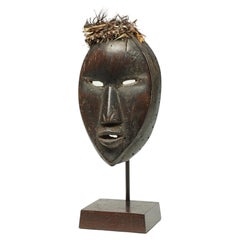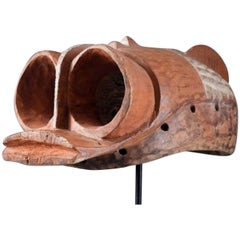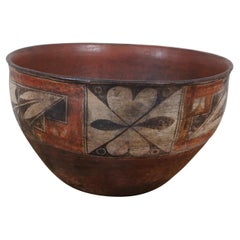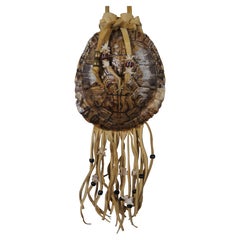Ohio - Tribal Art
to
745
530
2
2
1
2
1
1
1
1
2
2
2
Item Ships From: Ohio
Antique African Carved Toma Landai Tribal Ceremonial Mask Guinea Art Horns
Located in Dayton, OH
Early antique hand carved Toma or Landai mask from Guinea, Africa. “These brooding, often quite large, masks represent a forest spirit, Landai. Masks lik...
Category
Early 20th Century Tribal Ohio - Tribal Art
Materials
Raffia, Hardwood
Pair African Yoruba Figures with Shell Capes
Located in Toledo, OH
Pair of male and female African figures made of carved wood with capes made of sea shells. Each figure stands 11 1/2" tall x 6 1/2" wide.
Category
20th Century Ohio - Tribal Art
Materials
Shell, Wood
Related Items
Expressive Early Classic Cubist Dan Mask Early 20th Century Liberia, ex Sothebys
Located in Point Richmond, CA
Expressive early classic cubist Dan mask with refined expressive look, narrow open eyes and mouth and fine line scarification marks around outside of face. Created early 20th century by the Dan People...
Category
Early 20th Century Liberian Tribal Ohio - Tribal Art
Materials
Wood
$9,500
H 9.5 in W 5.75 in D 3.75 in
Nocturnal Bird Mask, Nigeria, Africa, circa 1950
Located in San Pedro Garza Garcia, Nuevo Leon
Very beautiful mask with large pronounced eyes with the circular cavity shape. The mask depicts a nocturnal bird that can see in the darkness and manifest the presence of divinities ...
Category
Mid-20th Century Nigerian Tribal Ohio - Tribal Art
Materials
Wood
African Tribal Yoruba, Nigeria Rider Figure Offering Bowl Early 20th Century
Located in Point Richmond, CA
Early Yoruba offering bowl in the from of a male figure with a beard riding on horse back surrounded by four small attendants, finely carved with nice patina from native use. Probabl...
Category
Early 20th Century Nigerian Tribal Ohio - Tribal Art
Materials
Wool
$1,400 Sale Price
28% Off
H 10.5 in W 6 in D 6 in
Tribal Style Songye Kifwebe Mask, D. R. Congo
Located in Point Richmond, CA
This graphic Songye Kifwebe mask has fine carved lines curved over the eyes and diagonal lines radiating from the nose and mouth in classic Kifwebe form. ...
Category
Late 20th Century Congolese Tribal Ohio - Tribal Art
Materials
Wood
Yoruba Nigeria African Red Royal Beaded Headdress Crown on Lucite Stand
Located in North Hollywood, CA
West African hand beaded head dress crown from Yoruba, Nigeria.
This artistic beautiful and functional art piece is covered with beads in ivory, red and black colors with faces bird...
Category
Mid-20th Century Nigerian Tribal Ohio - Tribal Art
Materials
Metal
$1,850
H 46 in W 10 in D 10 in
Antique Congolese African Tribal Carved Hemba Helmet Mask, Suku Peoples
Located in Forney, TX
A scarce antique African tribal carved Hemba helmet mask, the Suku peoples, possibly Kwese culture, Democratic Republic of the Congo, Central Africa, early 20th century, surmounted by four-legged animal, over round face, with mouth ajar and incised jagged teeth exposed, protruding almond shaped eyes, scattered remnants of pigment, full raffia fiber fringe, mounted on wood stand.
A superb museum quality example, this remarkable tribal folk art sculpture is a wonderful way to add rustic warmth, rich historical depth, and fascinating cultural interest to any space!
Dimensions: (approx)
Overall: 26" High, 9" Wide, 10.25" Deep;
Mask only: 15" Tall;
7 lbs total
Provenance / Acquisition:
Acquired from the highly reputable auction house, Austin Auction Gallery, est.1983, Austin, Texas.
Excellent Condition:
Nicely aged distressed patina over the whole. Highly desirable wear consistent with age and indicative of use, including scattered losses, antique character marks and typical signs of aging throughout. Retaining scattered remnants of original pigment. Overall a superb museum quality example
Primitive Arts Of Africa:
Among the Suku of the southwestern part of the Democratic Republic of the Congo, masks plays crucial role in protecting boys during initiation, the vulnerable period between boyhood and manhood. The power contained in Hemba masks...
Category
Early 20th Century Congolese Tribal Ohio - Tribal Art
Materials
Raffia, Wood
$2,600
H 26 in W 9 in D 10.25 in
Kuba Mask African Bwoom Tribal Congo in Wood, Vibrates Vegetables, Animal Hair
Located in Milano, IT
The African Kuba Bwoom tribal mask is the oldest known mask, the Kuba bwoom mask. The materials used for the realization of the Mask are: Wood, colors and vibrates plants, caures, beads, animal hair. In dance it expresses exuberance and joy. The style is similar to that of the middle Kasai. This mask is a helmet with animal hair, carved with a very wide forehead and hollow cheeks that are announced by motifs or dashes and beads. The mouth of the mask is very pronounced carved in wood and then applied on the mask. To distinguish the forehead in different areas are used black and white beads to draw attention to other aspects of the face such as the nose and chin. The entire edge of the chin is surrounded by beads of various colors. The person wearing the mask cannot look because there are no holes for the eyes present; the mask must create the feeling of being blind. Some masks similar to the bwoom mask include the funny mask, the ram mask and initiation masks such as Nnup.
The real Kuba masks...
Category
1620s Congolese Tribal Antique Ohio - Tribal Art
Materials
Animal Skin, Organic Material, Wood
$2,855 Sale Price
20% Off
H 11.82 in W 9.45 in D 15.75 in
Nepal Wood Dance Mask with Open Mouth Teeth, Late 19th Century
Located in Point Richmond, CA
Oval dance mask from Nepal with powerful expression, open eyes and oval mouth with finely carved teeth, nicely carved ears. Heavy black encrusted patina inside and out from tradition...
Category
Late 19th Century Nepalese Tribal Antique Ohio - Tribal Art
Materials
Wood
Yoruba Nigeria African Royal Beaded Headdress Crown on Lucite Stand
Located in North Hollywood, CA
West African hand beaded head dress crown from Yoruba, Nigeria.
This artistic beautiful and functional art piece is covered with beads in turquoise, orange, green, yellow red, blue ...
Category
Mid-20th Century Nigerian Tribal Ohio - Tribal Art
Materials
Metal
Vintage Display Mask, African, Ironwood, Carved, Ceremonial, Tribal, Decorative
Located in Hele, Devon, GB
This is a vintage display mask. An African, carved ironwood ceremonial tribal mask, dating to the late 20th century.
Fascinating ridged carvings accentuate this distinctive mask
Di...
Category
Late 20th Century Malawian Tribal Ohio - Tribal Art
Materials
Wood
$978
H 15.16 in W 13.19 in D 2.76 in
Woven Painted Basketry Old Yam Helmet Mask Sculptural Face Papua New Guinea
Located in Point Richmond, CA
Woven painted basketry yam helmet style mask from Papua New Guinea. Hollow woven form with traces of red and white pigments. Would have been put on top of a large yam as a part of th...
Category
Mid-20th Century Papua New Guinean Tribal Ohio - Tribal Art
Materials
Organic Material
$760 Sale Price
20% Off
H 14.5 in W 8.5 in D 12.5 in
Early 20th Century Hand-Carved Wood Tribal Mask from Atoni Tribe Timor
Located in Jimbaran, Bali
This very flat mask originates from the Atoni people of Timor. For the Timorese people masks portray both male and female ancestors, worn by warriors to scare off enemies or during c...
Category
Early 20th Century Indonesian Other Ohio - Tribal Art
Materials
Wood
$500
H 6.11 in W 5.12 in D 0.02 in
Previously Available Items
Antique 19th Century Zia Pueblo Southwestern Polychrome Pottery Dough Bowl 16"
Located in Dayton, OH
Very large and impressive, circa 1880's, Zia Pueblo polychrome dough bowl. Round shape with slightly tapered base, crafted of red clay, decorated with a band of red, white, and black geometric motifs.
The Zia Pueblo, situated atop a basalt mesa in north-central New Mexico, is comprised of Keresan-speaking Indians who have continuously occupied the site since the 13th century. Over 600 years old, Zía Pueblo has two plazas, each with a kiva, surrounded by one and two-story traditional dwellings of native rock surfaced with mud. Zia Pueblo is home to the Spanish mission of Nuestra Señora de la Asunción, the construction of which began around 1694. Archaeologists believe that the Zia people are descendants of the Ancestral Puebloan (Anasazi) people of the Four Corners region, who migrated to the Jemez River Valley sometime in the 13th century. Located between the slopes of the Sierra Nacimiento Mountains and the San Pedro River Valley, the Zia people have long lived an agricultural lifestyle, primarily growing corn, beans, and squash in shared or common ground, to which everyone contributed. Other minor crops were grown in personal, individual gardens, such as peppers, onions, chilies, and tobacco. The people also hunted small and large game. Homes at the pueblo were built with the local basalt and mud mortar, covered in mud plaster. The principal festival of the year for the Zia Pueblo is the Corn Dance on the feast day of Our Lady of the Assumption in August. Wonderful traditional costumes and ceremonies make this an important event in the life of the Pueblo and one which is very attractive to visitors. In recognition of Zia’s long history and unique culture, the Zia Pueblo is listed in the National Register of Historic Places. Famous for their large storage jars and huge dough bowls / vessels, Zia pottery...
Category
1880s Native American Antique Ohio - Tribal Art
Materials
Pottery
H 9 in W 15.75 in D 15.75 in
Vintage Native American Turtle Medicine Bag Pouch Leather Bone Beaded
Located in Dayton, OH
Vintage Native American medicine bag or pouch fashioned out of the shell of a box turtle and buckskin leather with cords and fringe accent...
Category
Late 20th Century Native American Ohio - Tribal Art
Materials
Bone, Leather, Shell, Beads
1995 Vintage Southwestern Beaded Turtle Medicine Bag Pouch Buffalo Nickel
Located in Dayton, OH
Vintage Native American style medicine bag or pouch fashioned out of the shell of a box turtle and buckskin leather, decorated around the edge with red and green beads and buttons made out of “Indian Head” / Buffalo nickels...
Category
1990s Native American Ohio - Tribal Art
Materials
Leather, Shell, Beads
H 5.5 in W 1.75 in D 4.75 in
Vintage Native American Ceremonial Dance Regalia Turtle Rattle Shaker 14
Located in Dayton, OH
Vintage Native American ceremonial rattle / shaker fashioned out of the shell of a box turtle on a wooden dowel, accented with a silver tone...
Category
Late 20th Century Native American Ohio - Tribal Art
Materials
Shell, Hardwood, Beads
Vintage Native American Ceremonial Dance Tomahawk War Club 22"
Located in Dayton, OH
Vintage Native American ceremonial dance / war club tomahawk with heavy studded concrete / stone head painted in red with wood branch handle...
Category
Late 20th Century Native American Ohio - Tribal Art
Materials
Stone
Vintage Yoruba Nigerian African Beaded Tribal Ceremonial Chiefs Arm Chair
Located in Dayton, OH
Vintage Yoruba Nigerian beaded tribal armchair featuring geometric patterns with alligators / crocodiles, antelope / gazelle, lions, masked faces, plants, parrots, eagles, birds elephants, and buffalo.
Traditionally made for the Yoruba tribe Kings and Queens, Yoruba chairs...
Category
Late 20th Century Tribal Ohio - Tribal Art
Materials
Glass, Hardwood, Beads
Mid-Century Carved African Dogon Marriage Stool Altar Bench Tribal Seat
Located in Dayton, OH
"Carved wood marriage bench or stool featuring a rectangular footed base with pierced sides bearing carved geometric and figural accents, surmounted by seat formed of male and female figure torsos joined at the waist with linked arms to either side and sculptural heads at end.
These benches were presented to brides on their wedding day as a symbol of the union with her new husband. Dogon people / tribe (Western Africa, Mali). Measures:33".
Additional history:
DOGON (DOGO, DOGOM, HABBE, HABE, KADO, KADDO, KIBISI, TOMBO)
Mali, Burkina Faso
The 400,000 Dogon live 180 miles south of Timbuktu on the cliffs of Bandiagara, which dominate the plains for over 150 miles. They speak approximately 120 dialects, many of which are not mutually comprehensible. At first hunters, now on their small fields they cultivate millet, sorghum, wheat, and onion. The millet is stored in high quadrangular granaries around which they build their houses. Because of the difficult approach to these regions and the aridity of the climate, the Dogon have been isolated and hence were able to conserve their ancient religious habits and ways of making the necessary implements, their carvings.
Dogon social and religious organizations are closely interlinked and out of this arose principal cults, which accounts for the richness and diversity of Dogon culture and art. The clans are subdivided onto lineages, overseen by the patriarch, guardian of the clan’s ancestral shrine and officiant at the totemic animal cult. Beside this hierarchical system of consanguinity, male and female associations are entrusted with the initiations that take place by age group, corresponding to groups of newly circumcised or excised boys or girls. The Dogon believe these operations remove the female element from males and vice versa. Circumcision thus creates a wholly male or female person prepared to assume an adult role. The members of an age group owe one another assistance until the day they die. Initiation of boys begins after their circumcision, with the teaching of the myths annotated by drawings and paintings. The young boys will learn the place of humans in nature, society, and the universe. In the Dogon pantheon Amma appears as the original creator of all the forces of the universe and of his descendant Lebe, the god of plant rebirth. The first Dogon primordial ancestors, called Nommo, were bisexual water gods. They were created in heaven by the creator god Amma and descended from heaven to earth in an ark. The Nommo founded the eight Dogon lineages and introduced weaving, smithing, and agriculture to their human descendants.
For these various cults the hogon is both priest and political chief of the village. He is also in charge of the cult of lebe, the mythical serpent. Assisted by the blacksmith, he presides over agrarian ceremonies. The smiths and woodcarvers, who form a separate caste, transmit their profession by heredity. They may only marry within their own caste. Women are in charge of pottery making.
Dogon art is extremely versatile, although common stylistic characteristics – such as a tendency towards stylization – are apparent on the statues. Their art deals with the myths whose complex ensemble regulates the life of the individual. The sculptures are preserved in innumerable sites of worship, personal or family altars, altars for rain, altars to protect hunters, in market. As a general characterization of Dogon statues...
Category
Mid-20th Century Tribal Ohio - Tribal Art
Materials
Hardwood
Vintage African Bamileke Juju Feather Hat Wall Hanging Medallion Boho
Located in Dayton, OH
Vintage handmade African Juju feather hat, made of brown and white feathers. Measures: 32”.
Category
20th Century Folk Art Ohio - Tribal Art
Materials
Silk, Feathers
Monumental African Tribal Burkina Faso Horned Bobo Ceremonial Mask Helmet
Located in Dayton, OH
Monumental African Tribal Burkina Faso Horned Bobo Ceremonial mask helmet 66"
Monumental tribal hardwood horned bobo mask. The perfect sculptural wall obj...
Category
20th Century Tribal Ohio - Tribal Art
Materials
Hardwood
Hagenauer Styled Native Sculptures
Located in Cincinnati, OH
A pair of native sculptures in the style of Hagenauer with a dark ebony toned finish, hand-carved wood with copper loops and spears mounted on matching bases . A great pair to highli...
Category
Mid-20th Century Unknown Tribal Ohio - Tribal Art
Materials
Wood
Vintage Survey Sticks with Stands
By WPA
Located in Cincinnati, OH
A vintage survey stick in the style of the WPA with markings that have a very tribal Folk Art look sitting on custom iron bases. These are half pieces f...
Category
Mid-20th Century American Folk Art Ohio - Tribal Art
Materials
Wood
Hagenauer Native Sculpture
By Werkstätte Hagenauer Wien
Located in Cincinnati, OH
A sculpture in the manner of Hagenauer Werkstatte of a kneeling native hunter in a dark ebony finish with copper details mounted on a matching base.
Category
20th Century Unknown Folk Art Ohio - Tribal Art
Materials
Copper
Recently Viewed
View AllMore Ways To Browse
African Spear Currency
Ancestor Figure Papua New Guinea
Antique Ethiopian Crosses
Brazil Feather Headdress
Brazil Headdress
Copper African Masks
Dogon Mask
Tribal Crocodile Wood
Wedding Headdress
African Tribal Carved Wood Drum
Amazon Headdress
Asmat Tribal
Dogon Figure
Fiji Club
Fijian War Club
Gelede Mask
Kuba Beaded
Mali Doors
